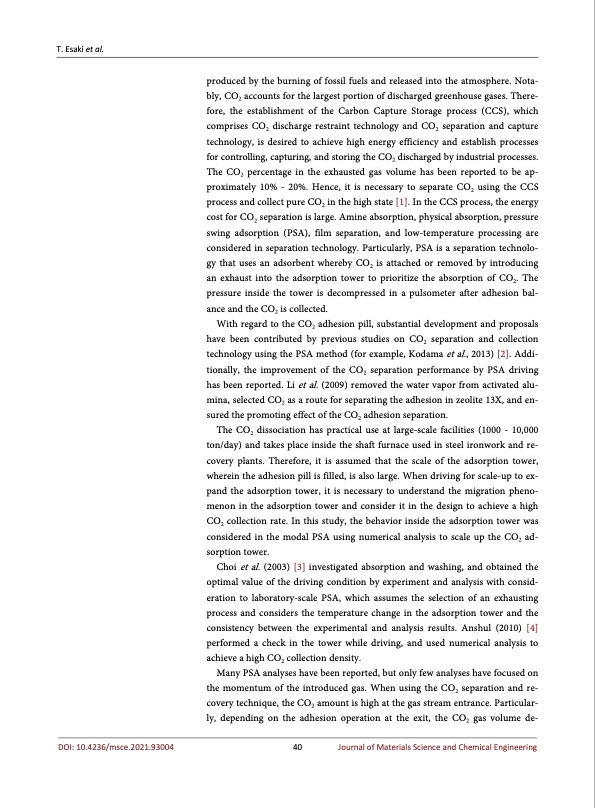
PDF Publication Title:
Text from PDF Page: 002
T. Esaki et al. produced by the burning of fossil fuels and released into the atmosphere. Nota- bly, CO2 accounts for the largest portion of discharged greenhouse gases. There- fore, the establishment of the Carbon Capture Storage process (CCS), which comprises CO2 discharge restraint technology and CO2 separation and capture technology, is desired to achieve high energy efficiency and establish processes for controlling, capturing, and storing the CO2 discharged by industrial processes. The CO2 percentage in the exhausted gas volume has been reported to be ap- proximately 10% - 20%. Hence, it is necessary to separate CO2 using the CCS process and collect pure CO2 in the high state [1]. In the CCS process, the energy cost for CO2 separation is large. Amine absorption, physical absorption, pressure swing adsorption (PSA), film separation, and low-temperature processing are considered in separation technology. Particularly, PSA is a separation technolo- gy that uses an adsorbent whereby CO2 is attached or removed by introducing an exhaust into the adsorption tower to prioritize the absorption of CO2. The pressure inside the tower is decompressed in a pulsometer after adhesion bal- ance and the CO2 is collected. With regard to the CO2 adhesion pill, substantial development and proposals have been contributed by previous studies on CO2 separation and collection technology using the PSA method (for example, Kodama et al., 2013) [2]. Addi- tionally, the improvement of the CO2 separation performance by PSA driving has been reported. Li et al. (2009) removed the water vapor from activated alu- mina, selected CO2 as a route for separating the adhesion in zeolite 13X, and en- sured the promoting effect of the CO2 adhesion separation. The CO2 dissociation has practical use at large-scale facilities (1000 - 10,000 ton/day) and takes place inside the shaft furnace used in steel ironwork and re- covery plants. Therefore, it is assumed that the scale of the adsorption tower, wherein the adhesion pill is filled, is also large. When driving for scale-up to ex- pand the adsorption tower, it is necessary to understand the migration pheno- menon in the adsorption tower and consider it in the design to achieve a high CO2 collection rate. In this study, the behavior inside the adsorption tower was considered in the modal PSA using numerical analysis to scale up the CO2 ad- sorption tower. Choi et al. (2003) [3] investigated absorption and washing, and obtained the optimal value of the driving condition by experiment and analysis with consid- eration to laboratory-scale PSA, which assumes the selection of an exhausting process and considers the temperature change in the adsorption tower and the consistency between the experimental and analysis results. Anshul (2010) [4] performed a check in the tower while driving, and used numerical analysis to achieve a high CO2 collection density. Many PSA analyses have been reported, but only few analyses have focused on the momentum of the introduced gas. When using the CO2 separation and re- covery technique, the CO2 amount is high at the gas stream entrance. Particular- ly, depending on the adhesion operation at the exit, the CO2 gas volume de- DOI: 10.4236/msce.2021.93004 40 Journal of Materials Science and Chemical EngineeringPDF Image | Analysis of CO2 Pressure Swing Adsorption

PDF Search Title:
Analysis of CO2 Pressure Swing AdsorptionOriginal File Name Searched:
msce_2021033014050895.pdfDIY PDF Search: Google It | Yahoo | Bing
CO2 Organic Rankine Cycle Experimenter Platform The supercritical CO2 phase change system is both a heat pump and organic rankine cycle which can be used for those purposes and as a supercritical extractor for advanced subcritical and supercritical extraction technology. Uses include producing nanoparticles, precious metal CO2 extraction, lithium battery recycling, and other applications... More Info
Heat Pumps CO2 ORC Heat Pump System Platform More Info
| CONTACT TEL: 608-238-6001 Email: greg@infinityturbine.com | RSS | AMP |